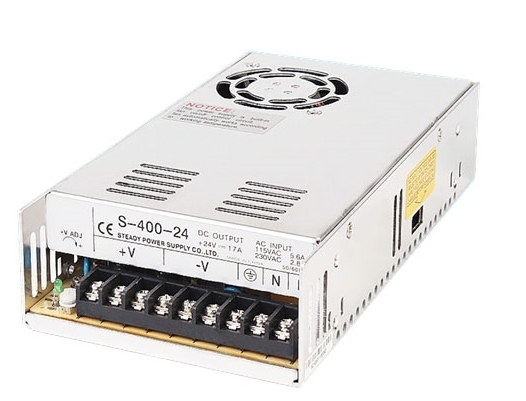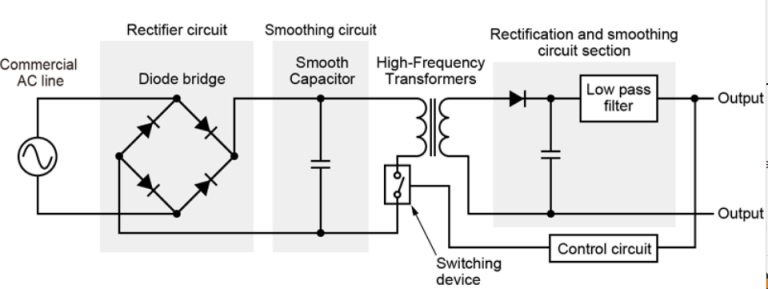
In this article, we will explore the differences between switching power supplies and linear power supplies in greater detail. We will discuss their operation, advantages, and disadvantages, as well as their applications. By the end of this article, you will have a better understanding of which type of power supply is best suited for your needs.
Ⅰ.The Introduction of the Linear Power Supplies and Switching Power Supply
What is Linear Power Supplies?
There are several uses for the linear power supply. The fact that it is widely used is directly related to the overall beneficial performance it provides. It should come as no surprise that the majority of designers and engineers in the electronics industry choose using components that have a proven track record of reliability and longevity. Given that linear power supply technology is well-established and reliable, this also applies to it.
A switch-mode power supply (SMPS) offers higher performance than a linear power supply, despite the latter’s general lack of efficiency. Examining the electronics industry closely reveals that linear power supplies are often used in areas where tight noise suppression is required.
What is Switching Power Supply?

The development of power electronic technology is closely correlated with the ongoing evolution of switching power supply technology. Nowadays, switching power supplies are widely used in almost all electronic devices because of their compact design, low weight, and high efficiency. It is a crucial power supply strategy given the current electronic information industry’s rapid development.
In order to maintain a steady output voltage, switching power supplies employ modern power electronics technology to control the time ratio of on and off switching. The most popular parts of switching power supply are MOSFETs and PWM control integrated circuits.
There is a relationship between the linear and switching power supplies. After its input terminal immediately rectifies the alternating current into direct current while operating under the influence of the high-frequency oscillation circuit, the switching tube is used to control the on-off of the current to create a high-frequency pulse current. A high frequency transformer, or inductor, is used to supply a constant low voltage direct current.
Ⅱ.Advantages and Disadvantages of a Linear Power Supply and Switching Power Supply
The Advantages of a Linear Power Supply
Many benefits come with the linear power supply, such as a simpler design and overall reduced cost. But like with almost everything in life, there are drawbacks to positives. These drawbacks include higher heat generation, which results in loss, and reduced efficiency in the case of the linear power supply.
In addition to being simple, dependable, and noisy-free, linear power sources are also inexpensive to construct. Another name for linear power supply is linear regulators (LRs). A linear power supply can be constructed with fewer components, which makes for simpler designs and less expensive manufacture. This implies that engineers and designers typically favor them for the same reasons.
Disadvantages of a Linear Power Supply
According to the principles of electronics and physics, a device (linear power supply) with fewer components will naturally have fewer problems. Using a linear power supply also has the advantage of enhanced reliability.
The Advantages of a Switching Power Supply
More recent products on the market, switching power supplies use switching regulators to effectively convert electrical power. A switching-mode supply’s pass transistor, in contrast to a linear power supply, constantly alternates between full-on, full-off, and low-dissipation states. It also spends very little time in the high-dissipation transitions, reducing the amount of energy wasted. One significant benefit of switching power supply is this increased power conversion efficiency 1. Additionally, because switching power supplies have a smaller transformer and weigh less than linear supplies, they are typically much smaller and lighter 21. Nevertheless, switching power sources are more complex because of the necessary electronics on the PCB, and if they are not properly suppressed, they may result in electrical noise issues.
Disadvantages of a Switching Power Supply
More recently introduced to the market, switching power supply efficiently convert electrical power by including switching regulators. In contrast to a linear power supply, the pass transistor in a switching-mode supply spends relatively little time in the high dissipation transitions and alternates constantly between the low-dissipation, full-on, and full-off states, minimizing energy waste. Additionally, because switching power supplies use smaller transformers and weigh less overall, they are typically much lighter and smaller than linear supplies 21. Switching power supply, however, are more complex because of the necessary electronics on the PCB and might result in electrical noise issues if they are not properly suppressed 1. Furthermore, electromagnetic interference (EMI) produced by switching power sources may cause problems for other devices or systems.
Ⅲ.Comparison of Linear and Switching Power Supplies

The switching power supply mainly includes input grid filter, input rectifier filter, inverter, output rectifier filter, control circuit and protection circuit. Their functions are:
1. Input grid filter: Eliminate interference from the grid, such as interference caused by the starting of motors, switching of electrical appliances, lightning strikes, etc., and also prevent the noise generated by the switching power supply from spreading to the grid.
2. Input adjustment filter: adjusts the grid input voltage to provide DC voltage for the converter.
3. Inverter: It is a key part of the switching power supply. It converts DC voltage into high-frequency AC voltage and plays the role of isolating the output part from the input grid.
4. Output correction filter: adjusts the high-frequency AC voltage output from the converter to obtain the required DC voltage, while also preventing high-frequency noise from interfering with the load.
5. Control circuit: detect the output DC voltage, compare it with the reference voltage, and amplify it. Modulates the pulse width of the oscillator, thereby controlling the converter to maintain a stable output voltage.
6.Protection circuit: When an overvoltage or overcurrent short circuit occurs in the switching power supply, the protection circuit stops the switching power supply to protect the load and the power supply itself.
The switching power supply rectifies the alternating current into direct current, then inverts the direct current into alternating current, and then rectifies the output into the required direct current voltage. In this way, the switching power supply eliminates the need for the transformer and voltage feedback circuit in the linear power supply. The inverter circuit in the switching power supply is completely digitally adjusted and can also achieve very high adjustment accuracy.
The main working principle of the switching power supply is that the upper and lower bridge Mos tubes are turned on in turn. First, the current flows in through the upper bridge Mos tube. The storage function of the coil is used to gather the electric energy in the coil. Finally, the upper bridge Mos tube is closed and the lower bridge Mos tube is turned on. The bridge’s Mos tube, coil and capacitor continue to supply external power. Then the lower bridge Mos tube is closed, and then the upper bridge is opened to let the current enter, and this is repeated. Because the Mos tube needs to be turned on and off in turn, it is called a switching power supply.
The linear power supply is different. Since there is no switch involved, the water supply pipe is always discharging water. If there is too much water, it will leak out. This is why we often see that the Mos tube of some linear power supplies generates a lot of heat. The endless electrical energy is all converted into heat energy. From this perspective, the conversion efficiency of linear power supplies is very low, and when the heat is high, the life of the components is bound to decrease, affecting the final use effect.
Ⅳ.The main difference between switching power supplies and linear power supplies is their working methods

The linear power supply power device works in a linear state, so it keeps working as soon as the power device is used, so its working efficiency is low, usually between 50[[%]]~60[[%]], and it must be said that it is Very good linear power supply. The working method of the linear power supply must make it change from high voltage to low voltage with a voltage device, usually a transformer, but there are also others like KX power supply, and then correct the output DC voltage. As a result, it is large, heavy, inefficient, and generates a lot of heat. It also has its advantages: small ripple, good adjustment rate, and small external interference. Suitable for analog circuits, mass firefighters, etc.
Switching power supply, its device power supply works in a switching state (on and off, on and off, the frequency is very fast, the frequency of the general flat-panel switching power supply is 100~200KHz, and the module power supply is 300~500KHz). In this way, its collection is small and efficient, and it also has requirements for the transformer, which is made of high magnetic permeability materials. It’s a little ink-stained, and his transformer is just one character small. The efficiency is about 80% to 90%. I heard that the best VICOR module in the United States is as high as 99%. The switching power supply has high efficiency and small size, but compared with the linear power supply, its ripple and voltage and current regulation rate are attenuated.
The working process of the main circuit of the linear power supply is that the input power is first subjected to preliminary AC voltage stabilization by the pre-stabilizing circuit, and then converted into DC power through isolation and rectification by the main working transformer, and then controlled by the control circuit and the single-chip microprocessor controller under the intelligent control. The linear adjustment component is finely adjusted to output a high-precision DC voltage source.
1.Power transformer and rectifier: convert 380V AC power into the required DC power.
2. Pre-stabilizing circuit: Use relay components or thyristor components to pre-adjust and initially stabilize the input AC or DC voltage, thereby reducing the power consumption of linear adjustment components, improving work efficiency, and ensuring high accuracy of the output voltage source. and high stability.
3. Linear adjustment component: Finely adjust the filtered DC voltage so that the input voltage reaches the required value and accuracy requirements.
4. Filter circuit: Block and absorb the pulsation wave, interference, and noise of the DC power supply to the maximum extent, thereby ensuring that the output voltage of the DC power supply has low ripple, low noise, and low interference.
5.Single-chip microcomputer control system: The single-chip microprocessor controller compares, judges, calculates, analyzes and other processes on various detected signals, and then issues corresponding control instructions to make the overall voltage stabilizing system of the DC stabilized power supply work normally and reliably. ,coordination.
11.Display: Display of the output voltage value and output current value of the DC regulated power supply.
Ⅴ.Applications of Linear and Switching Power Supplies
Applications of linear power supplies include audio and video equipment, which includes amplifiers, as well as other applications that require strict noise mitigation.
Switching power supplies are generally better suited for high-power applications due to their higher efficiency, smaller size, and lower cost.
They are commonly used in applications such as battery charging for Lithium-Ion batteries used in aviation and vehicles, electroplating, anodizing, and electroforming processes, DC motors, slot cars, aviation, and marine applications, R&D, manufacturing, and testing equipment, and waste treatment or fuel cell applications .




